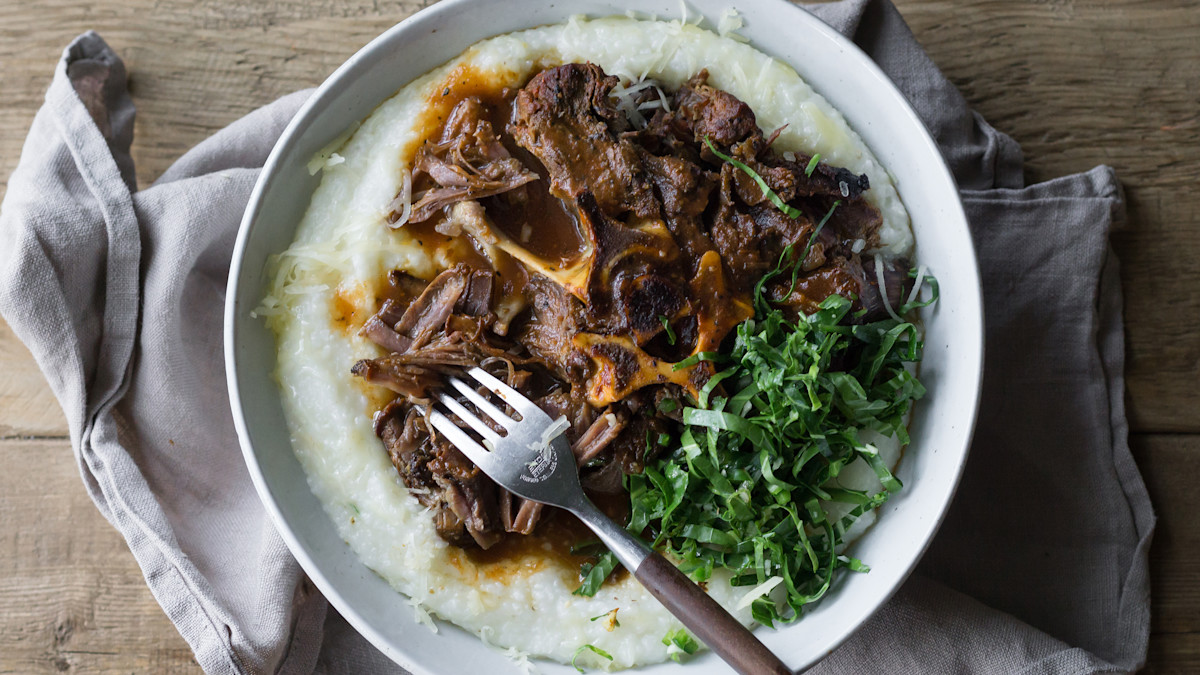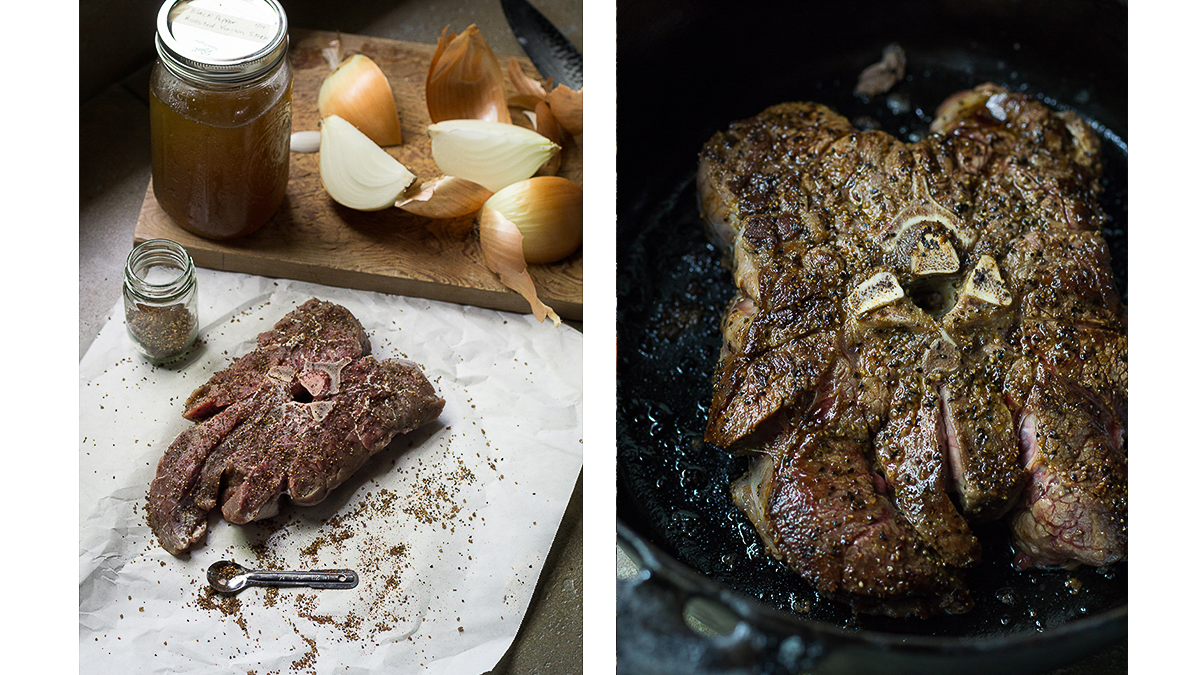
Course
Main
Duration
5+ hours
Serves
4
The neck meat from any ungulate is tough, making it ideal for slow cooking. Braise this less-popular cut in a homemade barbeque sauce and serve with cheesy grits for a meal that will convert anyone who doesn’t save the neck.
Because vertebrae have so many nooks and crannies, the neck can be hard to de-bone without wasting meat. My favorite way to process neck is to cut it crosswise into 4-inch-thick slices, the same way you would a shank for osso buco. This changes the texture of the meat when cooked because you’ve cut against the grain. You no longer have long strands of meat, rather small clusters that tear away on the fork between the dissolved connective tissue.
If you live in an area where CWD is present, the meat should be deboned.
Ingredients
- 2 neck chops, approximately 3 to 4 inches thick, or 2 pounds worth
- 1 tbsp. smoked sea salt
- 1 tbsp. black pepper
- ½ tsp. ancho chili powder
- ¼ tsp. smoked paprika
- ¼ tsp. garlic powder
- ¼ tsp. onion powder
- 1 whole onion, cut into wedges
- 2 tbsp. apple cider vinegar
- 2 tbsp. tomato paste
- 2 cups venison stock, plus more as needed
- 2 tbsp. brown sugar
- Pat of butter for finishing
- Oil for cooking
- Pickled mustard seeds and or cheesy grits for serving
Also works with
Special equipment
Preparation
- Prepare the neck by using a sharp knife to cut the meat into 3-4” chops. Use a saw to finish cutting through bone. It’s easiest to do this when the meat is nearly frozen.
- Mix the smoked sea salt, pepper, ancho, paprika, garlic, and onion powder. Rub a generous amount of this spice mix over the meat before cooking. For best results, do this step up to 24 hours in advance. Reserve what you do not use.
- Pre-heat an oven to 275 degrees.
- Bring the meat to room temperature before cooking. Pat excess liquid with paper towels. Add roughly a tablespoon of cooking oil to a large Dutch oven. Brown the neck chops on each side over medium-high heat. Work in batches as necessary. Remove the browned meat and set aside.
- Add more oil to the Dutch oven if needed and char the onion wedges on all sides. Deglaze with the apple cider vinegar and venison stock. Stir in the tomato paste and reserved spice mix until well mixed, then return the meat back to the Dutch oven. You want enough liquid to cover half of the meat. Add more stock if needed.
- Cover the Dutch oven with a lid and transfer to the oven to finish cooking.
- Every couple hours, baste the meat with the juices as needed. Cook until the meat is fork-tender.
- Remove the meat to a serving platter. Use a fine mesh strainer to remove the solids. Return the liquids to the Dutch oven and add the brown sugar. Reduce over high heat if a richer sauce is desired. Finish with a pat of butter for gloss and season to taste.
- Serve the neck chop with the sauce, pickled mustard seeds, and cheesy grits.
Sign In or Create a Free Account
Reviews
The neck meat from any ungulate is tough, making it ideal for slow cooking. Braise this less-popular cut in a homemade barbeque sauce and serve with cheesy grits for a meal that will convert anyone who doesn’t save the neck.
Because vertebrae have so many nooks and crannies, the neck can be hard to de-bone without wasting meat. My favorite way to process neck is to cut it crosswise into 4-inch-thick slices, the same way you would a shank for osso buco. This changes the texture of the meat when cooked because you’ve cut against the grain. You no longer have long strands of meat, rather small clusters that tear away on the fork between the dissolved connective tissue.
If you live in an area where CWD is present, the meat should be deboned.
Ingredients
- 2 neck chops, approximately 3 to 4 inches thick, or 2 pounds worth
- 1 tbsp. smoked sea salt
- 1 tbsp. black pepper
- ½ tsp. ancho chili powder
- ¼ tsp. smoked paprika
- ¼ tsp. garlic powder
- ¼ tsp. onion powder
- 1 whole onion, cut into wedges
- 2 tbsp. apple cider vinegar
- 2 tbsp. tomato paste
- 2 cups venison stock, plus more as needed
- 2 tbsp. brown sugar
- Pat of butter for finishing
- Oil for cooking
- Pickled mustard seeds and or cheesy grits for serving
Also works with
Special equipment
Preparation
- Prepare the neck by using a sharp knife to cut the meat into 3-4” chops. Use a saw to finish cutting through bone. It’s easiest to do this when the meat is nearly frozen.
- Mix the smoked sea salt, pepper, ancho, paprika, garlic, and onion powder. Rub a generous amount of this spice mix over the meat before cooking. For best results, do this step up to 24 hours in advance. Reserve what you do not use.
- Pre-heat an oven to 275 degrees.
- Bring the meat to room temperature before cooking. Pat excess liquid with paper towels. Add roughly a tablespoon of cooking oil to a large Dutch oven. Brown the neck chops on each side over medium-high heat. Work in batches as necessary. Remove the browned meat and set aside.
- Add more oil to the Dutch oven if needed and char the onion wedges on all sides. Deglaze with the apple cider vinegar and venison stock. Stir in the tomato paste and reserved spice mix until well mixed, then return the meat back to the Dutch oven. You want enough liquid to cover half of the meat. Add more stock if needed.
- Cover the Dutch oven with a lid and transfer to the oven to finish cooking.
- Every couple hours, baste the meat with the juices as needed. Cook until the meat is fork-tender.
- Remove the meat to a serving platter. Use a fine mesh strainer to remove the solids. Return the liquids to the Dutch oven and add the brown sugar. Reduce over high heat if a richer sauce is desired. Finish with a pat of butter for gloss and season to taste.
- Serve the neck chop with the sauce, pickled mustard seeds, and cheesy grits.







